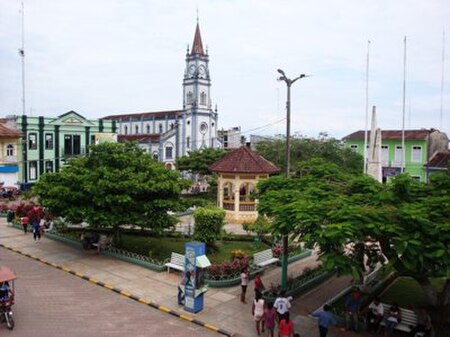Prana
|
Read other articles:

Державний комітет телебачення і радіомовлення України (Держкомтелерадіо) Приміщення комітетуЗагальна інформаціяКраїна УкраїнаДата створення 2003Керівне відомство Кабінет Міністрів УкраїниРічний бюджет 1 964 898 500 ₴[1]Голова Олег НаливайкоПідвідомчі орг�…

Rebellion during Tughlaq era in India Ismail Mukh's rebellion against the Delhi sultanatePart of Decline of the Tughlaq dynastyDate1346–1347LocationDeccanResult Rebellion victory[1]Territorialchanges Establishment of the Bahmani Sultanate in the Deccan region.Belligerents Bahmani SultanateDeccani Amirs Delhi SultanateCommanders and leaders Ismail Mukh AfghanAla-ud-Din Bahman ShahMalik Yal Afghan Muhammad bin TughluqNizam-ud-din (POW)Imad-ul-Mulk †Malik JauharBurhan-ud-d…

此条目序言章节没有充分总结全文内容要点。 (2019年3月21日)请考虑扩充序言,清晰概述条目所有重點。请在条目的讨论页讨论此问题。 哈萨克斯坦總統哈薩克總統旗現任Қасым-Жомарт Кемелұлы Тоқаев卡瑟姆若马尔特·托卡耶夫自2019年3月20日在任任期7年首任努尔苏丹·纳扎尔巴耶夫设立1990年4月24日(哈薩克蘇維埃社會主義共和國總統) 哈萨克斯坦 哈萨克斯坦政府與�…

2023 single by Lil Durk F*ck U ThoughtSingle by Lil Durkfrom the album Almost Healed (Deluxe) ReleasedAugust 18, 2023Length3:18Label Only the Family Alamo Songwriter(s) Durk Banks Darrell Jackson Producer(s)Chopsquad DJLil Durk singles chronology Pelle Coat (2023) F*ck U Thought (2023) Hellcats SRTs (2023) Music videoF*ck U Thought on YouTube F*ck U Thought is a single by American rapper Lil Durk, released on August 18, 2023 as the lead single (third overall) from the upcoming deluxe version of …

1985 Indian filmInsaaf Main KaroongaaPromotional PosterDirected byShibu MitraProduced byB. S. SethStarringRajesh KhannaTina MunimPadmini KolhapureMusic byBappi LahiriProductioncompanySeth Films InternationalRelease date 22 November 1985 (1985-11-22) Running time190 minutesCountryIndiaLanguageHindi Insaaf Main Karoongaa (lit. 'I will deliver justice') is a 1985 Hindi drama film directed by Shibu Mitra,[1] produced by B.S. Seth and presented by S.K. Kapur. This film ha…

Practices that prevent or reduce competition in a market by a business or government Unfair competition redirects here. For the 2001 Italian film, see Unfair Competition (film). Competition law Basic concepts History of competition law Monopoly and oligopoly Coercive monopoly Natural monopoly Barriers to entry Herfindahl–Hirschman index Market concentration Market power SSNIP test Relevant market Merger control Anti-competitive practices Monopolization Collusion Formation of cartels Price fixi…

Artikel ini tidak memiliki referensi atau sumber tepercaya sehingga isinya tidak bisa dipastikan. Tolong bantu perbaiki artikel ini dengan menambahkan referensi yang layak. Tulisan tanpa sumber dapat dipertanyakan dan dihapus sewaktu-waktu.Cari sumber: Beatbox – berita · surat kabar · buku · cendekiawan · JSTOR Beatboxing (4:26) Seorang beatboxer mendemonstrasikan berbagai varietas. Bermasalah memainkan berkas ini? Lihat bantuan media. Beatbox adalah sala…

Emperor of India from 1806 to 1837 This article needs additional citations for verification. Please help improve this article by adding citations to reliable sources. Unsourced material may be challenged and removed.Find sources: Akbar II – news · newspapers · books · scholar · JSTOR (May 2017) (Learn how and when to remove this message) Akbar IIKing of Delhi BadshahShahanshah-e-HindPortrait of Akbar Shah II, c. 182719th Mughal EmperorReign19 Novemb…

United States military medal for gallantry in action This article is about United States military decoration. For other uses, see Silver Star (disambiguation). AwardSilver Star MedalTypePersonal Valor DecorationAwarded forGallantry in action against an enemy of the United StatesPresented by United States Department of the Army[1] United States Department of the Navy[2] United States Department of the Air Force[3] United States Department of Homeland Security[4] El…

United States historic placeMount Washington Mill Historic DistrictU.S. National Register of Historic Places Show map of BaltimoreShow map of MarylandShow map of the United StatesLocation1330--1340 Smith Avenue and 1405-1407 Forge Ave., Baltimore, MarylandCoordinates39°22′6″N 76°38′59″W / 39.36833°N 76.64972°W / 39.36833; -76.64972Area4.8 acres (1.9 ha)NRHP reference No.90000727, 01001376[1]Added to NRHPMay 4, 1990, December 28, 2001 (Bo…

مجموعة من المسافرين يتقاسمون وجبة بسيطة من الخبز والشراب ..القرن الرابع عشر (14); . يتضمن مطبخ القرون الوسطى الأطعمة، عادات الأكل، وطرق الطهي من مختلف الثقافات الأوروبية خلال العصور الوسطى، وهي فترة تعود تقريباً من القرن الخامس إلى القرن السادس عشر. خلال هذه الفترة، تغيرت الوج…

العلاقات اليمنية المدغشقرية اليمن مدغشقر اليمن مدغشقر تعديل مصدري - تعديل العلاقات اليمنية المدغشقرية هي العلاقات الثنائية التي تجمع بين اليمن ومدغشقر.[1][2][3][4][5] مقارنة بين البلدين هذه مقارنة عامة ومرجعية للدولتين: وجه المقارنة اليمن م…

Former local authority in Middlesex, England HendonLocal Government District (1879–1894)Urban District (1894–1932)Municipal Borough (1932–1965)Hendon Town HallHendon within Middlesex in 1961Area • 18948,382 acres (34 km2) • 196510,369 acres (42 km2) Population • 190122,450 • 1961151,843 History • Created1879 • Abolished1965 • Succeeded byLondon Borough of Barnet StatusUrban district (1894-193…

Battersea Dogs & Cats HomeJenisYayasanIndustriKesejahteraan hewanDidirikan1860PendiriMary TealbyKantorpusatBritania RayaTokohkunciClaire Horton, Chief ExecutiveHeather Love, ChairSitus webbattersea.org.uk Battersea Dogs & Cats Home (sebelumnya Battersea Dogs Home) adalah sebuah tempat penampungan hewan yang menyelamatkan kucing dan anjing yang membutuhkan pertolongan, dan merawat mereka sampai seorang pemilik atau rumah baru dapat ditemukan. Tempat tersebut didirikan di Holloway pada 186…

Apostolic vicariate in Peru Apostolic Vicariate of YurimaguasApostolicus Vicariatus YurimaguaënsisCathedral of Our Lady of the SnowsLocationCountryPeruStatisticsArea70,000 km2 (27,000 sq mi)Population- Total- Catholics(as of 2010)252,000216,000 (85.7%)Parishes23InformationDenominationCatholic ChurchSui iuris churchLatin ChurchRiteRoman RiteEstablished27 February 1921 (103 years ago)CathedralCatedral Virgen de la NievesCurrent leadershipPopeFrancisVicar Apostolic el…

This article does not cite any sources. Please help improve this article by adding citations to reliable sources. Unsourced material may be challenged and removed.Find sources: Saga Prefectural Saga Technical High School – news · newspapers · books · scholar · JSTOR (February 2023) (Learn how and when to remove this message)Secondary school in Saga City, Saga Prefecture, JapanSaga Technical High SchoolSaga Technical High school front viewLocationSaga City…

Questa voce sugli argomenti film drammatici e film biografici è solo un abbozzo. Contribuisci a migliorarla secondo le convenzioni di Wikipedia. Segui i suggerimenti del progetto di riferimento. Il ragazzo della GiudeccaTitoli di testa dal trailer del filmLingua originaleItaliano Paese di produzioneItalia Anno2016 Durata95 min Rapporto2,35:1 Generedrammatico, biografico RegiaAlfonso Bergamo SoggettoAlfonso Bergamo, Mario Paradiso Jr, Craig Peritz SceneggiaturaAlfonso Bergamo Produttore…

1906 massacre of the Moro RebellionMoro Crater MassacrePart of the Moro Rebellion phase of the Philippine–American WarU.S. Marines pose with Moro dead after the battleLocationBud Dajo, Jolo, PhilippinesDateMarch 5–8, 1906TargetMoro peopleVictims800–900 Tausugs, most of which being women and childrenPerpetratorsUnited States Army and Marine Corps Major General Leonard Wood Colonel Joseph Wilson Duncan vteMoro Rebellion Bayang Hassan uprising Taraca Malalag River 1st Bud Dajo 2nd…

Questa voce sull'argomento ciclisti francesi è solo un abbozzo. Contribuisci a migliorarla secondo le convenzioni di Wikipedia. Segui i suggerimenti del progetto di riferimento. Julien El FaresJulien El Fares alla Quatre Jours de Dunkerque 2015Nazionalità Francia Altezza173 cm Ciclismo SpecialitàStrada Termine carriera2021 CarrieraSquadre di club 2005 La Pomme Marseille2006AVC Aix-en-Provence2006 Cofidisstagista2007AVC Aix-en-Provence2007 Cofidisstagista2008-2011 …

